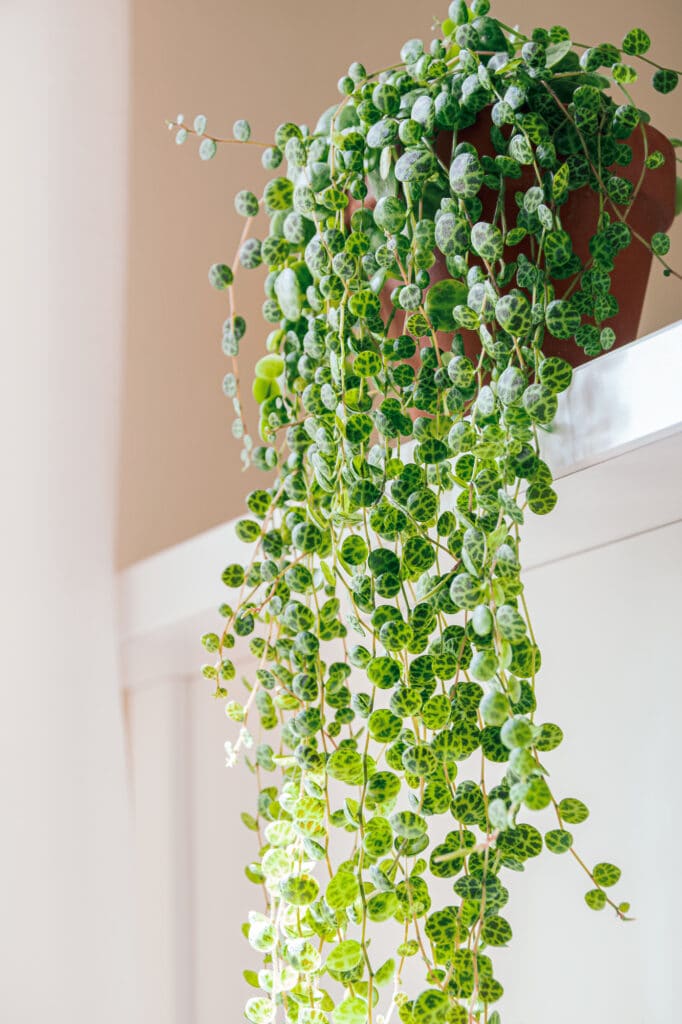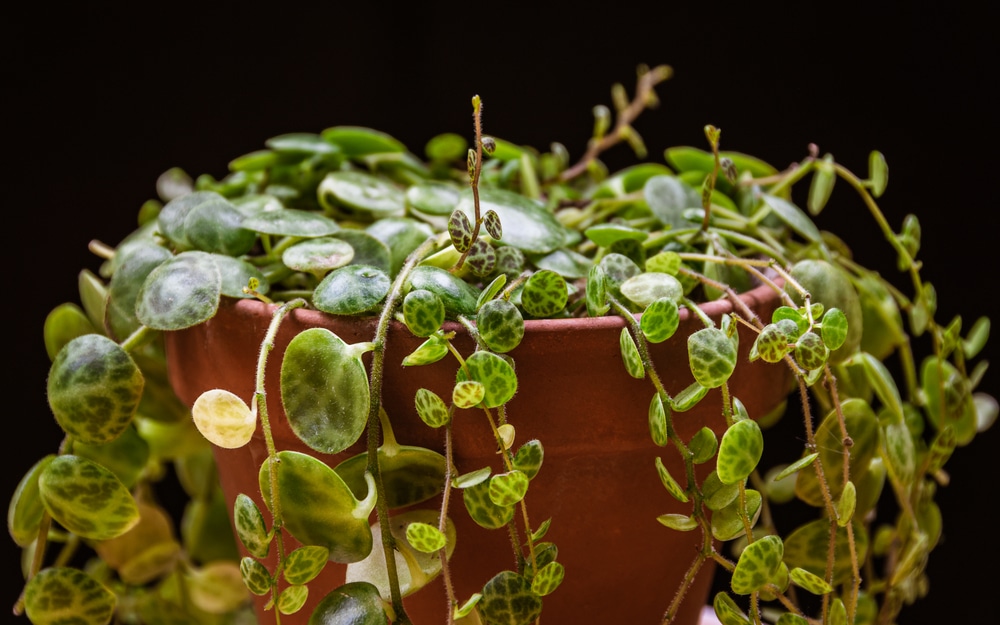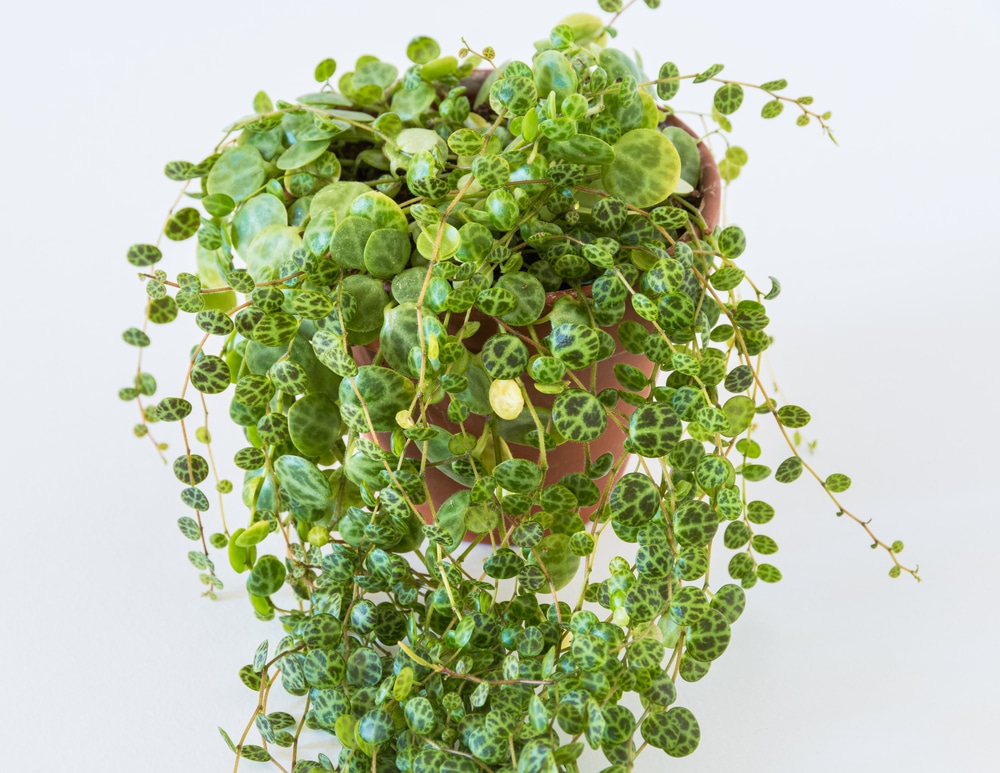Peperomia prostrata is a semi-succulent houseplant that is perfect for making a statement in small spaces. It is also called a String of Turtles plant because of its vining trails of flat, bead-like leaves with a turtle-back venation pattern. This easy houseplant is forgiving of neglect and tolerant of varying conditions. It is a great plant for both beginners and seasoned houseplant lovers alike. In this guide, we will show you everything you need to know about Peperomia prostrata!
About Peperomia Prostrata
Despite its semi-succulent status, Peperomia prostrata is actually a tropical plant native to the rainforests of Brazil. Also referred to as the String of Turtles plant because of its distinctive vining leaves, this plant makes a statement without taking up too much space. The small leaves are about the size of a dime with a dark green base and dramatic white veining.
The vines of Peperomia prostrata typically don’t grow longer than about a foot, but a full String of Turtles plant can look lush either in a hanging basket or trailing down a shelf.
This plant has exploded in popularity recently and is now considered a common houseplant. Luckily, it is also easy to care for and propagate once you learn what it wants.
If you like Peperomia prostrata, you may also like some of the other “string” plant varieties:
- Ceropegia woodii (String of Hearts) – This vining plant with cute heart-shaped leaves comes in many color varieties. If you prefer a longer vine than Peperomia prostrata, the String of Hearts can grow many feet long with proper care!
- Hoya curtisii – This beautiful trailing plant has impressive coloration on its leaves like the markings on String of Turtles. However, the leaves are much thinner and less succulent. Hoyas can also be finicky plants, so consider this option an upgrade for more experienced plant parents.
- Senecio rowleyanus (String of Pearls) – This popular succulent has thick bead-like leaves resembling—you guessed it—pearls! If you want something a little different, consider its relative Senecio/Curio herreianus (String of Tears).
Keep reading to learn everything you need to know about caring for a Peperomia prostrata (String of Turtles) plant.

String of Turtles Care
Like most plants in the Peperomia family, Peperomia prostrata is compact and easy to care for, making it a great plant for new plant owners. It is a slow-growing plant, so don’t be alarmed if your String of Turtles doesn’t experience a major growth spurt even after following these tips. Peperomia prostrata will reward you in the long run with lush, succulent leaves that make a statement at any scale.
Growth Habit
Like other peperomia plants, Peperomia prostrata is slow-growing and tends to stay small. Its thin vines do well draping over a hanging pot and grow to be about a foot long in normal household conditions.
If you’re starting out with a smaller String of Turtles and would it to fill out more at the top, you can fold some of the long vines back up into the pot and lay them on top of the dirt. This will encourage the vines to root in the soil and start their own trails! Alternately, you can propagate the turtle leaves and replant them into your pot to help fill it out.
Peperomia prostrata, like all houseplants, definitely has its preferred environment. Once you find a spot it’s happy it is best to avoid repeatedly moving around your plant. Given time and care, Peperomia prostrata is happy to adapt to most household conditions. However, repeatedly moving your plant around to new spots before it has time to adopt may prevent your String of Turtles from reaching its potential. (This does not include regular light rotation, which you should do for all houseplants!)
Light
As with many other tropical plants, Peperomia prostrata enjoys bright, indirect light. This plant can handle some small amounts of filtered direct sun, but too much will damage the leaves. Hang this plant near an unobstructed north, east, or west-facing window. If you have a South facing window, place your Peperomia prostrata at least 5 feet back from the window to avoid direct, intense beams.
If you don’t have a good window, String of Turtles can also do well under an artificial fluorescent grow light. If providing artificial light for your plant, it will need about 12 hours of light.
It may be tempting to hang vining plants like this up high. But, be careful to ensure that the top of the plant also receives enough light, or else your String of Turtles may go bald up top!
Water
As a semi-succulent tropical plant, watering is the easiest thing to get wrong with Peperomia prostrata.
Because it is succulent, you want to be sure that the soil has dried out on top before watering again. However, unlike regular succulents, avoid letting all of the moisture in the soil disappear before giving it a drink.
How often you’ll need to water to achieve this balance depends on factors in your home. Consider your humidity level, the amount of light the plant gets, and the size of the pot. Plants in small pots will dry out faster and need watering more often. In the spring and summer when more light tends to shine in through your windows and temperatures rise, your plant will need more regular watering.
Like other succulent plants, String of Turtles will also give you visual warnings when it’s time to water. If the normally-plump turtle leaves start to shrivel a bit and look more like raisins, your plant is probably thirsty.
When watering, be sure to let any excess water fully strain out of the bottom of the plant. If using a cachepot, dump any sitting water to avoid it getting soggy feet. Overwatering will kill Peperomia prostrata faster than underwatering so, when in doubt, wait to water!
Temperature and Humidity
Like other tropical plants, Peperomia prostrata enjoys temperatures of between 65-75 degrees (F) and average to high humidity. It’s okay if it gets a little warmer in the summer, but try to avoid cold weather. Avoid placing your plant near an air vent where it will be exposed to air conditioning or heat. These will dry out the leaves. Keep in mind that the higher the humidity around your Peperomia prostrata, the less you will need to water.
If you have low humidity in the area where your plant will live, try misting it every couple of days or investing in a humidifier. Peperomia prostrata also enjoys hanging out with other plants in the jungle, so feel free to place it near other tropical friends to create a happy plant environment.
Soil and Repotting
Although you may be tempted to use pre-made succulent soil for Peperomia prostrata, it’s almost always best to create your own mix. Try creating homemade soil mixtures made of peat moss or sphagnum moss, organic general potting soil, and perlite. This mix can also be used for most other peperomia and tropical houseplants, so it’s often efficient to create a big batch at once.
Since this plant is a slow grower, you may not need to report the plant for years (depending on how full it started out). You’ll know it’s time to repot if the roots of the plant are pushing up against the sides of the pot or poking out of the bottom holes. As with any houseplant, only repot into a planter one sizer bigger and avoid repotting in the fall or winter. The vines on Peperomia prostrata are delicate, so expect a few to fall or break off when handling. Don’t worry, though—you can always propagate these stray turtles!
Fertilizer
You can fertilize your String of Turtles about monthly in the spring and summer to encourage growth. Look for a liquid, general houseplant fertilizer and dilute it with water to half-strength. Skip fertilizing in the fall and winter. You usually don’t need to fertilize for the first year after bringing home your Peperomia prostrata from a big-box store. These stores already include plenty of fertilizer in the potting mix which will last until the next growing season.
Pruning
You won’t need to regularly prune your Peperomia prostrata, however, feel free to clip off any strands that have thinned out too much. If you let your String of Turtles dry out too much, prune away any dead or dried-up vines to encourage new growth to come in. Otherwise, you can prune the vines for length if you want to achieve a specific look. However, most people prefer to let their long vines grow!
Toxicity
String of Turtles is not known to be toxic to humans or animals, making it a pet friendly plant for your home! However, we still recommend keeping it out of reach of any curious critters, just in case.

Peperomia Prostrata Propagation
You can propagate Peperomia prostrata from vine clippings. Some people claim to have success propagating from a single turtle leaf. But, for best results, we recommend you include a whole piece of the stem in your clipping. String of Turtles can be propagated either in soil, sphagnum moss, or water. Follow these steps to propagate Peperomia prostrata:
- Using clean and sharp sheers, cut a 3 – 4 inch piece from a healthy vine, noting which is the cut end.
- Carefully remove the lowest leaf or two from the end you cut.
- Place the cut end of the vine an inch deep into the soil, moss, or water. Be sure that the nodes where you removed the leaves earlier are covered by the planting medium.
- If propagating in soil or moss: Lightly mist the soil, and then keep the medium moist by covering your baby plant with an open ziplock bag. When you see signs of new growth, you can remove the bag and care for the young plant as normal
- If propagating in water: Regularly change the water to prevent rot. When you see roots about a half-inch long, move the young plant into your potting medium
Now you know how to propagate a Peperomia prostrata! You can use your baby turtle plants to help fill out the parent plant. Or, create a whole new String of Turtles to share with a friend!
Common Pests and Diseases
Peperomia prostrata is not particularly prone to pests. However, you may notice some of these appear if not cared for well. Be sure to separate a sick Peperomia prostrata from your other plants so that the infestation doesn’t spread.
Mealybugs
If you notice white, cotton-like dots on your String of Turtles, you may have a mealybug infestation. They tend to hide on the underside of leaves, or on the stem of the plant. Mealybugs prefer to lay their eggs in wet and heavily fertilized soil, which is another reason to be sure to let your Peperomia prostrata dry out between watering. Luckily, you can treat them with insecticidal soap spray. Going forward, let your plant dry out more between watering to avoid future infestations.
Spider Mites
Spider mites are attracted to overly dry soil and look like tiny dots on the underside of leaves. One of the early warning signs of an infestation may be yellowing leaves or thin webbing climbing up the vines of your plant. You can also treat Spider Mites with insecticidal soap spray. Try also increasing the humidity in your room, and avoiding letting the soil completely dry out between watering.
Root Rot
Root rot is the most common issue most houseplant parents will face. For semi-succulent plants that need a delicate watering balance, this is especially true. Root rot is caused by overwatering. Root rot can be confusing to deal with because the symptoms resemble underwatering. This is because when plant roots rot from overly moist environments, it prevents them from actually delivering water to the plant. Unfortunately, this means you may continue to overwater a rotting plant at first making the issue worse.
The best way to deal with root rot is to avoid it by making sure soil mostly (but not entirely) dries out between watering. If the top inch or two of your Peperomia prostratai soil is moist, skip watering!
Once root rot occurs, you have limited options depending on how severe it has become. Most likely, the plant will die and you should focus on salvaging healthy clippings to propagate.
Common Questions
Here are a few of the most frequently asked questions about Peperomia prostrata (String of Turtles):
Why does my String of Turtles look bleached?
If the leaves on your Peperomia prostrata become bleached or faded, this is likely a sign that it is receiving too much light. Try moving it to an area with less intense light and avoid any direct sun rays.
Why is are my Peperomia prostrata vines so bare?
Bare (or “leggy”) vines on a String of Turtles probably mean your Peperomia prostrata is not getting enough light. This is especially common on the top side of vining plants that are hung high up in windows or placed on tall shelves. Try moving your plant to a place where the whole plant will get more light. If you want, feel free to prune away the bare vines to encourage new growth in the brighter environment.
Where can I find a Peperomia prostrata (String of Turtles)?
Peperomia prostrata is not exactly a rare plant, but you probably won’t find it in your local grocery store. Look for the String of Turtles in big box garden centers like Lowes or Home Depot, or in local houseplant shops. You can also order a Peperomia prostrata online from direct plant sellers or from fellow plant lovers on sites like Etsy or even Facebook marketplace.
Conclusion
This lovely semi-succulent plant is a great addition to any houseplant collection. Because it is easy, small, and pet-safe, this plant can fit well into any lifestyle, which also makes it a great gift! By following just a few simple instructions, you can enjoy the stunning design of the String of Turtles for many years.

